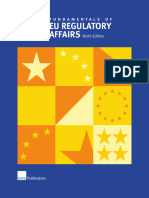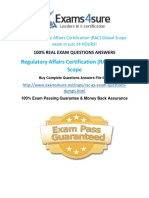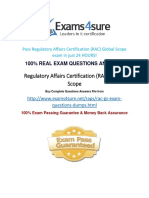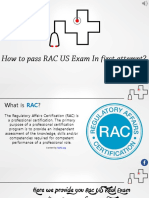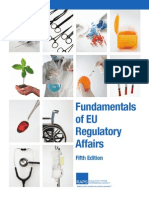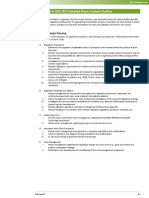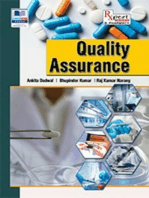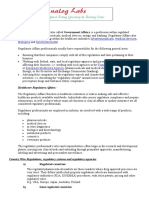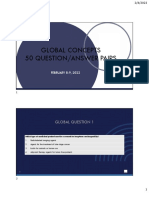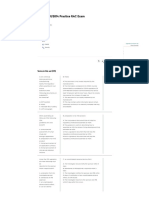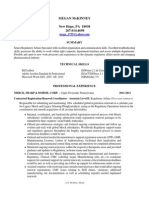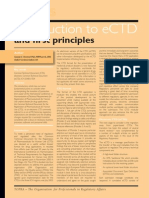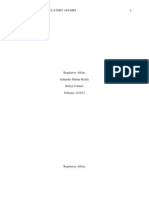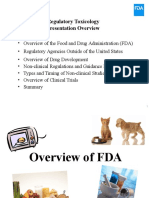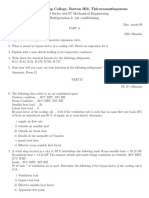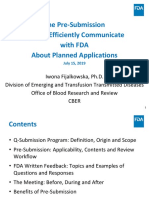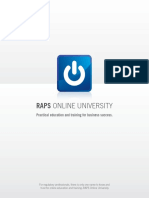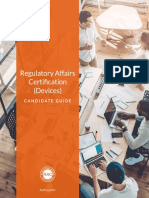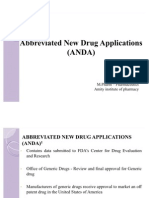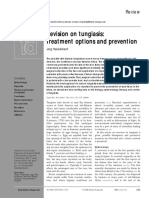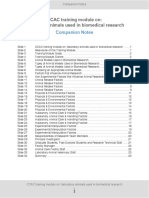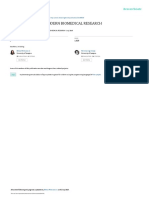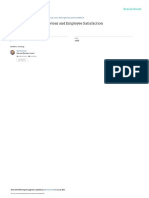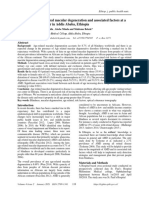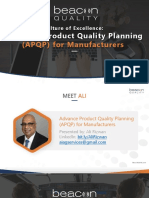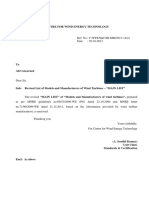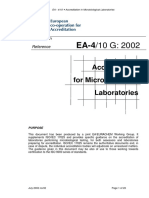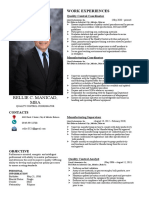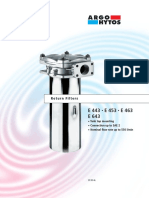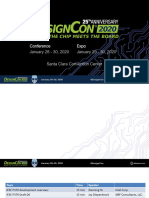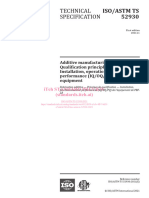0 ratings0% found this document useful (0 votes)
174 viewsRAC Review Chapter 10
RAC Review Chapter 10
Uploaded by
Ayele BizunehThis document provides an overview of key concepts in current good manufacturing practices (cGMP) regulations for pharmaceutical and medical device manufacturing. It discusses cGMP principles like building quality in, having controls at every step, and documenting all activities. Key elements of cGMP regulations are outlined, including requirements for facilities, equipment, materials, production, packaging and labeling, quality systems, records, microbiology and corrective and preventive action systems. International harmonization of cGMP standards is also addressed.
Copyright:
© All Rights Reserved
Available Formats
Download as PPTX, PDF, TXT or read online from Scribd
RAC Review Chapter 10
RAC Review Chapter 10
Uploaded by
Ayele Bizuneh0 ratings0% found this document useful (0 votes)
174 views35 pagesThis document provides an overview of key concepts in current good manufacturing practices (cGMP) regulations for pharmaceutical and medical device manufacturing. It discusses cGMP principles like building quality in, having controls at every step, and documenting all activities. Key elements of cGMP regulations are outlined, including requirements for facilities, equipment, materials, production, packaging and labeling, quality systems, records, microbiology and corrective and preventive action systems. International harmonization of cGMP standards is also addressed.
Original Title
RAC review Chapter 10 (1).pptx
Copyright
© © All Rights Reserved
Available Formats
PPTX, PDF, TXT or read online from Scribd
Share this document
Did you find this document useful?
Is this content inappropriate?
This document provides an overview of key concepts in current good manufacturing practices (cGMP) regulations for pharmaceutical and medical device manufacturing. It discusses cGMP principles like building quality in, having controls at every step, and documenting all activities. Key elements of cGMP regulations are outlined, including requirements for facilities, equipment, materials, production, packaging and labeling, quality systems, records, microbiology and corrective and preventive action systems. International harmonization of cGMP standards is also addressed.
Copyright:
© All Rights Reserved
Available Formats
Download as PPTX, PDF, TXT or read online from Scribd
Download as pptx, pdf, or txt
0 ratings0% found this document useful (0 votes)
174 views35 pagesRAC Review Chapter 10
RAC Review Chapter 10
Uploaded by
Ayele BizunehThis document provides an overview of key concepts in current good manufacturing practices (cGMP) regulations for pharmaceutical and medical device manufacturing. It discusses cGMP principles like building quality in, having controls at every step, and documenting all activities. Key elements of cGMP regulations are outlined, including requirements for facilities, equipment, materials, production, packaging and labeling, quality systems, records, microbiology and corrective and preventive action systems. International harmonization of cGMP standards is also addressed.
Copyright:
© All Rights Reserved
Available Formats
Download as PPTX, PDF, TXT or read online from Scribd
Download as pptx, pdf, or txt
You are on page 1of 35
IF IT WAS NOT DOCUMENTED, THEN IT WAS NOT DONE”
Fundamentals of US Regulatory Affairs
Chapter 8
Objectives
• Understanding GMP
• Understanding basic quality system concepts
and quality system regulations
• Overview of key GMP regulations
• Differences and similarities between
pharmaceuticals and medical devices
• Concept of clean design and process validation
Objectives (cont)
• Basic elements of sanitary equipment design
• Effective cleaning and sanitation programs
• CAPA system (Corrective And Preventative
Action)
• Cross-contamination risk within the
manufacturing environment
cGMP
(Current Good Manufacturing Practice)
• GMP should be “Designed” to be flexible to allow each
manufacturer to decide individually how to implement
the necessary controls by using scientific sound design,
processing methods and testing procedures
• The “C” in GMP means current – up to date
technologies
• Overall concept
– Quality should be built into the product
– Testing alone cannot be relied on to ensure product quality
• A product that is ‘fit for its purpose”
cGMP Principles
• Build QUALITY in - you cannot test or inspect
quality in to a product – it must first be quality
• Have controls in place for each step of the
process – increase the likelihood the product
produced in safe and fit for its intended
purpose
• Product the product from contamination and
cross-contamination and prevent mix-ups.
cGMP Principles (cont)
• Know what you are doing in advance and
document what really happened (document
everything)
• Work towards consistency and control and
monitor your system
• Have an independent Quality Assurance
Group
GMP is global
• It is influenced by international bodies
– ICH
– International Organization for Standardization
(ISO)
– cGMP Harmonization Analysis working group (FDA
2003) Modify 21CFR210 and 211 to meet ICH
GMP Regulations
• Non-biologics – FD&C Act section 501(a)(2)(b)
• Finished Pharmaceuticals – 21CFR211 – Clinical supply dosage
forms (including placebo) and commercially marketed dosage form
• ICH Q7A GMP for Active Pharmaceutical Ingredients
• Biologic Drug Products – 21CFR 210 and 211; 21CFR 600-680; comply
with BLA commitments and applicable standards
• Quality Systems - ISO9000, non-US Pharmaceutical quality
management requirements FDA Quality Requirement
System (QRS)
• Guidances and CPGM (Compliance Program Guidance Manuals) – for
FDA GMP inspections – details cleaning validation, water systems,
microbiological and QC labs, sterile bulk substance
cGMP Requirements
(as many regulations as GCP)
• A Quality System (change control, validation,
CAPA
• Qualified and trained personnel
• Fit for use buildings and facilities to meet the
purpose
• Equipment that is suitable, clean, maintained
and calibrated
cGMP Requirements (cont)
• Controls in place to prevent degradation or
contamination of materials (raw, in process and
final)
• Production and in-process controls for
performance monitoring and deviations
• Proper packaging and labeling – ID and
Protection
• Laboratory controls – specifications , samples,
testing
Generic Drugs and GMP
• Is identical or bioequivalent to a brand-name
drug in dosage form, safety, strength, route of
administration, quality, performance
characteristics and intended use
• Analytical testing of the chemical composition
of the generic is determined to be the same as
the branded product
Medical Devices
• FD&C Section 501(h) and 520(f)(1)
– Amended in 1976 - Medical Device Amendment
– 1978- Device GMP initiated
– 1996 – Revised ‘Quality System Regulations’
• Human factors techniques and data should be integral
considerations in all medical device design control components
• Each manufacturer must establish and maintain procedures for
verifying the design input
• Design validation must ensure devices conform to defined user
needs and intended users and must include testing of
production units under actual or simulated use conditions
• Design validation must include risk analysis and use error
Combination Products
• Utilize the capabilities of two or more
different product types to provide effective
health care (21CFR3.2(c)) and cGMP (21CFR
Part4 Subpart A)
• The drugs and devices are still covered by
individual regulations (21CFR210 and 211;
21CFR810 respectively)
cGMP for Phase 1 Investigational Drugs
• Guidance for Industry: Current GMP Practice for
Phase 1 Investigational Drugs (July 2008)
• 21CFR201.2 – If the Phase 1 drug is already marketed
or used in Phase 2 or 3 trials, then it is exempt from
21CFR211
• Trial Materials need
– Well-defined and written procedures
– Adequately controlled equipment and manufacturing
environment
– Accurately and consistently recorded data
cGMP for Phase 2 and Phase 3 Investigational Drugs
• Guidance: Preparation of Investigational New
Drug Products (1991)
Adulterated Drugs or Devices
• A drug or device is considered adulterated unless it is
manufactured in conformity with cGMP practices
(newest industry standards)
• A robust quality system is required to provide the
necessary framework for implementing Quality by
Design, continuous improvement and risk
management
• Whether documented on paper or electronic all data
must be able to be traced back to the source and
verified
Device Quality System Regulation (QSR)
• Quality System is the organizational structure,
responsibilities, procedures, processes and
resources for implementing process management
– Medical devices QSR are found in 21CFR820
– ICH Pharmaceutical Quality System Q10
• QSR states specific requiremnts for such key
elements as management responsibility, quality
planning, CAPA, design controls and purchasing
control
Corrective And Preventive Action (CAPA)
• Each Device manufacturer must maintain history
files, a device ,aster record and a device history
record for each type of device
• Every company must have quality plans and quality
system records that define its quality practices
• Device Manufactures are required to establish
purchasing controls and institute post-distribution
device failure investigations and CAPA for defects or
recurring technical problems
Pharmaceutical Quality System
• Guidance for Industry: Quality Systems Approach to Pharmaceutical
cGMP Regulations (June 2006); 21CFR210 and 211
• The six-system inspection model
– Quality system
– Facilities and equipment system
– Materials system
– Production system
– Packaging and labeling system
– Laboratory controls
• Robust Quality System will have
– SPOs
– Training
– Records and good documentation practive
QC vs. QA
Quality Control vs. Quality Assurance
• The QC unit monitors overall compliance with
cGMPs
• The QA units supplies oversight by auditing
the functions
• They identify and investigate OOS (Out-of-
Specification) results, deviations and failures
in both production and the analytical
laboratory.
Facilities and Equipment System
• Areas are designated as clean and dirty,
– Physical separation, equipment and staff for each
operation
• Specify personnel protection equipment and to
prevent contamination by humans
• Areas must operate to a single standard - GMP or
non-GMP
• Need to have designed into areas
– Building materials, air handling, temperature,
microbiology
Records
• Distribution records must be maintained to aid
in recalls
• Environmental Controls, Support systems,
Alerts, Action Limits must be established
• The environment must be controlled and
monitored to prevent product cross-
contamination and contamination by harmful
microorganisms or extraneous matter (filth)
Microbiology
• Effects on product
– Causing human illness
– Product
• Discoloration
• Malodors
• Production of gasses that can lead to package swelling or busting
• Breakdown in viscosity or elasticity
• Otherwise unable to perform as intended
• Types: contact or airborne/ bacterial, yeast or mold
• Resistance to product preservative system or sanitizers (think
antibiotic resistance)
• Classic Microbiology – takes 48-72 h for aerobic bacteria; 72-120 h
for yeast or mold
Microbiology – areas of risk
• Heat exchangers
• Air compressors
• Pumps
• Water systems (Grades of water – WFI)
• Valves
• Ancillary Equipment (O-rings, pipes, clamps, gaskets
• Effective Cleaning and Sanitation (C&S)
– Autoclaves, sanitizer, alcohol, steam generators
– CIP – Conducted on assembled equipment
– COP – Conducted on dissembled equipment
Material System
• The measurement and activities to control finished
products, components containers and closures
– Inventory Control Process
– Drug Storage
– Distribution Controls and Records
• Written procedures for the receipt, storage, testing
and approval or disapproval of raw materials
components, products, containers and closures
Production System
• Quality and manufacturing process and procedures (and
changes to them) must be defined, approved and
controlled.
• Batch numbering and maintaining proper traceability is
required
– Track batch, equipment use records and labeling used, personnel,
raw material controls are traceable
• Verification of all steps including sign-off are required for
critical process steps.
• All batch records must be reviewed na d have QA approval
before the product is released
Package and Labeling System
• FDA ‘recommends’ as part of the design process
and before commercial products that the controls
for all processes within the packaging and labeling
systems be planned and documented with written
procedures.
– Discriminating features of different products/strengths
– Distribution of all labels to manufacturing unit
– Reconciliation is performed between label issued,
applied and returned (damaged) to insure 100%
accountability
Laboratory Control system
• Laboratory Controls and written documentation
– Analytical Methods validation and laboratory
equipment qualification
– Scientifically sound stability program to support
labeled expiration dating
– Sampling program Statistical models to determine
sample scheme
– Proper training of QC staff to collect samples
• Batch, water, microbiology, etc.
– Retesting conditions
Critical Elements of Subsystems
• SOPs
– Describes how the company complies with the
drug or device regulations and are critical to GMP
compliance
– See GLP review on overall view of SOPs
– Change Control System – to prevent unintended
consequences to product quality
– Training
– Records
Verification, Qualification and Validation
apply to both Drugs and Devices
• All operational methodologies and procedures
utilized in manufacturing and testing be validated to
demonstrate they can function as intended
• Validation activities must be conducted I
accordance with approved protocols and
appropriate guidances
• Process validation ensures that product quality,
safety and effectiveness are designed and built into
the final product (batch to batch output uniformity)
Process Validation
• Guidance for Industry: Process Validation: General Principles
and Practices (January 2011)
– Stage 1 – Process Design: The commercial process is based on
knowledge gained through development and scale-up activities
– Stage 2 – Process Qualification: The process qualification is confirmed
as being capable of reproducible commercial manufacturing
– Stage 3 – Continued Process Verification: Ongoing assurance that the
process remains in a state of control during routine production.
Requires an ongoing program to collect and analyze product and
process data that relate to product quality (21CFR211.180(e))
• Requires an interdisciplinary team approach (process engineering, industrial
pharmacy, analytical chemistry, microbiology, statistics
• “Begin with the end in mind”
Method Validation
• Draft Guidance for Industry: Analytical Procedures
and Methods Validation – Chemistry
Manufacturing and Controls Documentation
(August 2000)
• Generics - USP
• Each method used to analyze the drug or biologic
must have associated validation to support the
documentation of drug substance, product
identity, strength, purity, and potency
Key GMP Concepts
Key GMP Concepts (cont)
Key GMP Concepts (cont)
IF IT WAS NOT WRITTEN DOWN, THEN IT WAS NOT DONE
You might also like
- Fundamental of US Regulatory Affairs 11 EditionDocument754 pagesFundamental of US Regulatory Affairs 11 Editioncyrilaaron0406100% (1)
- Fundamentals of EU Regulatory Affairs 9th EditionDocument681 pagesFundamentals of EU Regulatory Affairs 9th Editioncyrilaaron0406No ratings yet
- RAC Exam I Test Questions - Flash Cards Answer - KeyDocument101 pagesRAC Exam I Test Questions - Flash Cards Answer - KeyYesinta Diandra100% (5)
- RAC Questions AnswersDocument5 pagesRAC Questions AnswersJasper0% (1)
- RAC Exams QuestionsDocument14 pagesRAC Exams QuestionsExamsure983% (6)
- GM 3660 - Form - COMMODITY VALIDATION - CG4816Aug2018Document7 pagesGM 3660 - Form - COMMODITY VALIDATION - CG4816Aug2018marvek newman100% (1)
- RAC Past PapersDocument6 pagesRAC Past PapersOlivia Merchant0% (2)
- RAC US Exam QuestionsDocument18 pagesRAC US Exam QuestionsAna William50% (2)
- Fundamentals of EU Regulatory Affairs, Fifth Edition Comparative MatrixDocument42 pagesFundamentals of EU Regulatory Affairs, Fifth Edition Comparative Matrixasifmdzakaria70% (10)
- 2024 RAC-Drugs Candidate GuideDocument27 pages2024 RAC-Drugs Candidate GuideayoobNo ratings yet
- Fundamentals of International Pharmaceutical and Biologics RegulationsDocument296 pagesFundamentals of International Pharmaceutical and Biologics RegulationsPranay Ghiya100% (2)
- ISA Certified Automation Professional CAPDocument79 pagesISA Certified Automation Professional CAPLuis Guillermo Rodríguez A.50% (12)
- GMP in Pharmaceutical Industry: Global cGMP & Regulatory ExpectationsFrom EverandGMP in Pharmaceutical Industry: Global cGMP & Regulatory ExpectationsRating: 5 out of 5 stars5/5 (2)
- RAC EU Exam Content OutlineDocument3 pagesRAC EU Exam Content OutlineSenthil ThyagarajanNo ratings yet
- RAC US Exam QuestionsDocument5 pagesRAC US Exam QuestionsNikki Bella0% (1)
- FDA Submissions NCI INDDocument106 pagesFDA Submissions NCI INDDmitri Popov100% (4)
- Preparing For The RAC Exam: Regulatory Impact On BusinessDocument38 pagesPreparing For The RAC Exam: Regulatory Impact On BusinessLolaPachanoAbierto100% (4)
- Regulatory Affairs ProgramDocument10 pagesRegulatory Affairs ProgramSrushti090% (1)
- ECTD Digital HandbookDocument964 pagesECTD Digital Handbookpalkybd100% (5)
- RAC Qualifying ExamDocument9 pagesRAC Qualifying ExamVirg Sci-hiNo ratings yet
- Test Procedure of Electrical Distribution BoardDocument23 pagesTest Procedure of Electrical Distribution BoardRam Saran ChaudharyNo ratings yet
- Preparing Pre-Approval InspectionDocument34 pagesPreparing Pre-Approval Inspectionshah241100% (2)
- Current Good Manufacturing Practices (cGMP) for Pharmaceutical ProductsFrom EverandCurrent Good Manufacturing Practices (cGMP) for Pharmaceutical ProductsNo ratings yet
- Risk Management Applications in Pharmaceutical and Biopharmaceutical ManufacturingFrom EverandRisk Management Applications in Pharmaceutical and Biopharmaceutical ManufacturingHamid MollahNo ratings yet
- ICH Quality Guidelines: An Implementation GuideFrom EverandICH Quality Guidelines: An Implementation GuideAndrew TeasdaleNo ratings yet
- RAC Global Exam Content OutlineDocument3 pagesRAC Global Exam Content OutlinecrzyNo ratings yet
- 2019 RAC Candidate Guide EUDocument22 pages2019 RAC Candidate Guide EURonak choksiNo ratings yet
- Anupama Ra NotesDocument23 pagesAnupama Ra NotesShahzeel Iftikhar100% (1)
- RAC Drug Workshop Slides - Global 2022 - Questions and AnswersDocument74 pagesRAC Drug Workshop Slides - Global 2022 - Questions and Answersvinay100% (1)
- RAC Candidate GuideDocument25 pagesRAC Candidate Guideasifmdzakaria100% (1)
- 2003 - 2009 - 2014 Practice RAC Exam Flashcards - Quizlet PDFDocument5 pages2003 - 2009 - 2014 Practice RAC Exam Flashcards - Quizlet PDFLolaPachanoAbiertoNo ratings yet
- Senior Regulatory Affairs Specialist Pharmaceuticals in Philadelphia PA Resume Megan McKinneyDocument2 pagesSenior Regulatory Affairs Specialist Pharmaceuticals in Philadelphia PA Resume Megan McKinneyMeganMcKinneyNo ratings yet
- Regulatory Affairs Training - Mod 3Document95 pagesRegulatory Affairs Training - Mod 3Sunil Kumar100% (1)
- Regulatory Affairs Strategies For C M CDocument5 pagesRegulatory Affairs Strategies For C M CfadliNo ratings yet
- RAC Drug Workshop Slides - EU 2022 - Questions and AnswersDocument67 pagesRAC Drug Workshop Slides - EU 2022 - Questions and Answersvinay100% (1)
- Quality eCTD SubmissionsDocument7 pagesQuality eCTD SubmissionsRambabu komati - QA100% (6)
- eCTD BasicsDocument4 pageseCTD BasicspalkybdNo ratings yet
- ECTD Digital Handbook PDFDocument964 pagesECTD Digital Handbook PDFRaj IyerNo ratings yet
- NDA ProcessDocument3 pagesNDA Processdustymarie100% (2)
- USFundamentals Chapter36Document21 pagesUSFundamentals Chapter36Phan Do Dang KhoaNo ratings yet
- Drug Regulatory Affairs Interview Q&ADocument34 pagesDrug Regulatory Affairs Interview Q&APrakash Vanaparthi100% (3)
- Regulatory AffairsDocument14 pagesRegulatory AffairsSiddarth Reddy100% (2)
- USFDA Regulatory Toxicology OverviewDocument100 pagesUSFDA Regulatory Toxicology OverviewHarsh Koshti100% (1)
- Govt - Engineering College, Barton Hill, Thiruvananthapuram Second Series Test-S7 Mechanical Engineering Refrigeration & Air ConditioningDocument3 pagesGovt - Engineering College, Barton Hill, Thiruvananthapuram Second Series Test-S7 Mechanical Engineering Refrigeration & Air ConditioningRakesh NairNo ratings yet
- Getting Started With eCTDDocument39 pagesGetting Started With eCTDvkumar6883100% (1)
- Pre-Submission To FDADocument31 pagesPre-Submission To FDApgupta2004No ratings yet
- RAPS Brochure PDFDocument16 pagesRAPS Brochure PDFdvdynamic1No ratings yet
- Combination Products Regulatory PerspectiveDocument58 pagesCombination Products Regulatory Perspectivejmittal100% (1)
- Medical Devices Regulatory AffairsDocument3 pagesMedical Devices Regulatory Affairsprabalsoni125No ratings yet
- An Overview of The US Regulatory System For OTC ProductsDocument6 pagesAn Overview of The US Regulatory System For OTC Productsanimeluis100% (2)
- Regulatory System in AmericaDocument134 pagesRegulatory System in AmericaMicaela CajamarcaNo ratings yet
- Pharmaceutical DevelopmentDocument57 pagesPharmaceutical DevelopmentdeepakpharmatechNo ratings yet
- What Regulatory AffairsDocument4 pagesWhat Regulatory Affairssumit_gup01100% (1)
- 01 Regulatory Affairs Specialist CV TemplateDocument2 pages01 Regulatory Affairs Specialist CV TemplateMehmet Akif KücükNo ratings yet
- Postapproval CMC ChangesDocument12 pagesPostapproval CMC ChangesSondell100% (1)
- Regulatory Writer TrainingDocument12 pagesRegulatory Writer TrainingMostafa SalahNo ratings yet
- 2019 RAC Candidate Guide Devices V2Document25 pages2019 RAC Candidate Guide Devices V2Ronak choksi100% (1)
- Director Quality Assurance Regulatory Affairs in Miami FT Lauderdale FL Resume Mary JeanDocument2 pagesDirector Quality Assurance Regulatory Affairs in Miami FT Lauderdale FL Resume Mary JeanMaryJean2No ratings yet
- Abbreviated New Drug ApplicationDocument32 pagesAbbreviated New Drug Applicationramneet1990100% (1)
- Mapping A Path To Market: Creating A Comprehensive Drug Development StrategyDocument10 pagesMapping A Path To Market: Creating A Comprehensive Drug Development StrategyPixelateNo ratings yet
- Revision On Tungiasis: Treatment Options and Prevention: ReviewDocument7 pagesRevision On Tungiasis: Treatment Options and Prevention: ReviewAyele BizunehNo ratings yet
- Companion NotesDocument24 pagesCompanion NotesAyele BizunehNo ratings yet
- CCAC Training Module On: Laboratory Animals Used in Biomedical ResearchDocument24 pagesCCAC Training Module On: Laboratory Animals Used in Biomedical ResearchAyele BizunehNo ratings yet
- Animal Models in Modern Biomedical ResearchDocument5 pagesAnimal Models in Modern Biomedical ResearchAyele BizunehNo ratings yet
- Clinical Microbiology Reviews - 1998 - Baker - FullDocument36 pagesClinical Microbiology Reviews - 1998 - Baker - FullEliana HalaburdaNo ratings yet
- REVISED PUBLIC World Bank One Health Framework 2018Document152 pagesREVISED PUBLIC World Bank One Health Framework 2018Ayele BizunehNo ratings yet
- Ethical Leadership Behaviour and Employee Satisfaction: January 2010Document14 pagesEthical Leadership Behaviour and Employee Satisfaction: January 2010Ayele BizunehNo ratings yet
- Annex 6 Requirements For Rabies Vaccine For Veterinary Use (Requirements For Biological Substances No.29, Amendment 1992) IDocument4 pagesAnnex 6 Requirements For Rabies Vaccine For Veterinary Use (Requirements For Biological Substances No.29, Amendment 1992) IAyele BizunehNo ratings yet
- Rabies Investigation Guideline: (I Nclu de S Pot Ential Ex Po Sure Man Age Ment)Document35 pagesRabies Investigation Guideline: (I Nclu de S Pot Ential Ex Po Sure Man Age Ment)Ayele BizunehNo ratings yet
- 227 Manuscript 538 1 10 20210129Document5 pages227 Manuscript 538 1 10 20210129Ayele BizunehNo ratings yet
- Animal Research Perceptions Vs RealityDocument24 pagesAnimal Research Perceptions Vs RealityAyele BizunehNo ratings yet
- NVI Product Catalog 4 1Document40 pagesNVI Product Catalog 4 1Ayele Bizuneh100% (4)
- DETERMINANTS OF JOB SATISFACTION in A.A. Yesu GirmaDocument88 pagesDETERMINANTS OF JOB SATISFACTION in A.A. Yesu GirmaAyele BizunehNo ratings yet
- DIN EN 16842-1: in Case of Doubt, The German-Language Original Shall Be Considered AuthoritativeDocument23 pagesDIN EN 16842-1: in Case of Doubt, The German-Language Original Shall Be Considered AuthoritativeanupthattaNo ratings yet
- Software Processes: ©ian Sommerville 2004 Software Engineering, 7th Edition. Chapter 4 Slide 1Document50 pagesSoftware Processes: ©ian Sommerville 2004 Software Engineering, 7th Edition. Chapter 4 Slide 1beezkoNo ratings yet
- Bacharach IEQ, Bacharach IEC ChekDocument1 pageBacharach IEQ, Bacharach IEC ChekborescopeNo ratings yet
- (APQP) For Manufacturers: Advanced Product Quality PlanningDocument26 pages(APQP) For Manufacturers: Advanced Product Quality Planningpawar_kinjal110No ratings yet
- IVT Cleaning Validation IV 0Document87 pagesIVT Cleaning Validation IV 0Noemi100% (8)
- ASQR01 Rev 11 FINAL 08 - 31 - 2018Document17 pagesASQR01 Rev 11 FINAL 08 - 31 - 2018testNo ratings yet
- GMP Quality Assurance and Validation Procedures 2Document48 pagesGMP Quality Assurance and Validation Procedures 2gmpsop100% (4)
- Calibration and Validation of HPLC, GC and UV-VIS SpectrosDocument8 pagesCalibration and Validation of HPLC, GC and UV-VIS SpectrosDrAtiq Ur-RahmanNo ratings yet
- GKPI Quality ManualDocument46 pagesGKPI Quality ManualtarunNo ratings yet
- UVM RamakrishnaDocument54 pagesUVM Ramakrishnahv_chillal880% (2)
- CR PCHK 2019.2.0Document13 pagesCR PCHK 2019.2.0wang MrNo ratings yet
- Mba Cet 2018Document2 pagesMba Cet 2018Aarav AroraNo ratings yet
- Software Testing Life CycleDocument3 pagesSoftware Testing Life CycleRajasekaran100% (4)
- Centre For Wind Energy TechnologyDocument10 pagesCentre For Wind Energy TechnologyAntonyNo ratings yet
- Ea 4 10 Norma Iso MicrobiologiaDocument26 pagesEa 4 10 Norma Iso MicrobiologiaAlejandraCamachoNo ratings yet
- Stability Guidelines AgDocument32 pagesStability Guidelines AgVenugopal GowdaNo ratings yet
- Rellie Dela Cruz Manicad, MBADocument2 pagesRellie Dela Cruz Manicad, MBAArgel BobadillaNo ratings yet
- 1712-34 L3 Qualification Handbook v1Document66 pages1712-34 L3 Qualification Handbook v1sauloctNo ratings yet
- Iso 9001:2000 Sample Audit Plan Schedule (Registrar)Document0 pagesIso 9001:2000 Sample Audit Plan Schedule (Registrar)Muhammad ShafiNo ratings yet
- Argo Hytos e 453Document6 pagesArgo Hytos e 453Raúl FigueroaNo ratings yet
- DQ Report For BrineDocument12 pagesDQ Report For BrineNishit SuvaNo ratings yet
- (2022) BS EN ISO - Environmental Management - GuidelinesDocument38 pages(2022) BS EN ISO - Environmental Management - GuidelinesVinod MohanNo ratings yet
- Eexi - MEPC 335 76 Add2 - Annex9Document12 pagesEexi - MEPC 335 76 Add2 - Annex9Matija VasilevNo ratings yet
- Introduction To The IEEE P370 Standard and Its Applications For High Speed Interconnect CharacterizationDocument118 pagesIntroduction To The IEEE P370 Standard and Its Applications For High Speed Interconnect CharacterizationjalvesmoNo ratings yet
- Is.1828.2.2002 - Verification of UTM - IIDocument15 pagesIs.1828.2.2002 - Verification of UTM - IIVellingiri MyilsamyNo ratings yet
- Check List FSSC - ĐGNB Hung PhatDocument137 pagesCheck List FSSC - ĐGNB Hung PhatDuNo ratings yet
- Iso Astm TS 52930 2021Document11 pagesIso Astm TS 52930 2021Ankit SahuNo ratings yet

